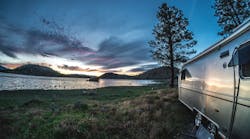The US Department of Energy (DOE) has again revised the requirements for the PAR38 LED lamp competition within the Bright Tomorrow Lighting Prize (L Prize) program. Lamps can now have a slightly wider beam pattern and the agency reduced some other burdens on manufacturers. Meanwhile, the DOE also announced a new solid-state lighting (SSL) research funding opportunity coming in the OLED space under the Small Business Innovation Research (SBIR) and Small Business Technology Transfer (STTR) programs.
The PAR38 L Prize competition was launched in 2008 alongside the competition for a 60W-equivalent A-lamp that Philips won in 2011. The PAR38 competition seeks a replacement for halogen incandescent lamps. The DOE had identified the A-lamp and the PAR38 as among the most broadly used lamps and therefore focused the L Prize on those products for sockets where LEDs could deliver the most energy savings.
L Prize participation
While the A-lamp drew Philips as an entrant early on and later GE Lighting and Lighting Science Group each announced their intention to enter, the PAR38 competition has yet to draw an entry. The DOE temporarily suspended the PAR38 competition in mid-2011, and then relaunched it in March 2012 with the most significant change being the number of sample lamps needed for a manufacturer to enter the competition.
The PAR38 L Prize remains a $5 million opportunity for a lamp manufacturer along with assurances that the US government will buy and utilize the winning lamp. Philips won $10 million for the A-lamp competition, but may have spent far more on R&D. Still, the effort left Philips Lighting at or near the top of the LED retrofit lamp technology space.
The latest revisions were made based on realities of the market, according to the DOE. The luminous intensity distribution spec has been expanded to a maximum allowable beam pattern of 15° from the prior 12° requirement.
The bigger changes may be in eligibility requirements. The rules had required usage of LEDs made in the US. The DOE will still require that final assembly of the lamp happens in the US and that entrants have a business presence in the US.
A change has also come in production requirements in the first year of lamp production. The DOE will no longer require an entrant to commit to producing 250,000 lamps in the first year after receiving the L Prize award.
OLED funding
The DOE also announced topics that are eligible for new FY 2014 SBIR and STTR funding including OLEDs. The formal funding opportunity announcement will come on August 12, 2013 with letters of intent due September 3, 2013 and applications due October 15, 2013.
The DOE also recently released a summary report on outdoor LED lighting that is based on research done in the agency's Caliper program. Highlights include efficacy statistics. Most of the tested products deliver system efficacy of 70–90 lm/W. The report also addresses color rendering and temperature. For complete coverage, see the detailed article on the Snapshot Report posted on our Illumination in Focus website.




